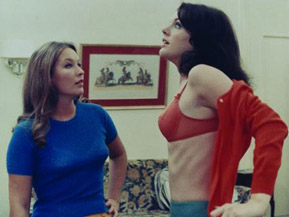Sole Criterion: 2 or 3 Things I Know About Her
By Brett Ballard-Beach
December 20, 2012
So the narrator expresses uncertainty (which I would argue is not Godard’s forte). Contrast this with the working conditions on the set. Godard gave earpieces to most of the cast members and most scenes that did not feature a dialogue or conversational exchange of some kind, but rather a monologue, or an actor/actress onscreen alone, were micro-managed by him to an almost ludicrous degree. He would pose them, tell them when to move their heads, whisper lines for them to repeat, pose questions for them to answer (in character) and/or instruct them to ad lib something along lines that had been discussed just prior to shooting the scene in question.
This technique results in a kind of bemused quizzical air on an audience’s part if unaware that this is taking place, but doesn’t detract from its success once the secret/charade is known. The characters become like the cityscape on display or the adverts and products so elegantly framed in ‘Scope by Godard’s go-to cinematographer in the 1960s, Raoul Coutard. Primary colors pop off the screen and the effect at times is, as the narrator notes in reference to something else, as vibrant “as a panel in a comic strip.”
Where, then, does my qualifier of the film’s “failure” come into play? To answer that, I present a comparison. 2 or 3 Things I Know About Her is a critique of capitalism and the drudgeries of modern middle-class living in a manner not all that dissimilar at times from Fight Club (directed by David Fincher and adapted by Jim Kouf.) There, as here, the accoutrements of our consumerist society are signified as the “products” of our undoing. (The narrator of 2 or 3 Things exclaims at one point, “Can’t afford LSD? Try watching a color TV.” The anonymous protagonist of Fight Club imagines filling the dimensions of his apartment with catalog furniture purchased from stores like IKEA.
And as much as I enjoyed the anarchic bent of Fight Club’s anti-capitalism screeds (but not so much the twist involving our narrator and his closest acquaintance Tyler Durden), I knew that the very marrow of the film’s arguments was lost to me as I watched the scene referenced above and thought, “Those things look nice. I wouldn’t mind having them in my house or apartment.” If it’s the false dichotomy between feeling “nothing” surrounded by one’s possessions and feeling “something” by pummeling a stranger or having the living shit round housed out of me, I’ll settle for the one with less blood, snot, and other bodily fluids.
In 2 or 3 Things, Coutard’s compositions are so artful, and a 360 degree pan in the middle of one of Juliette’s rooftop monologues so breathtaking that the visuals are always on the verge of threatening and upending the (verbal) philosophical arguments against the very environment they are depicting. Godard portrays a frequent number of scenes of construction taking place, bulldozers and cranes at work and looming freeways and loops that dwarf the vehicles that travel upon them—and often accompanied by the discordant noise associated with construction for several beats—but even that cacophony can’t entirely blemish the beauty of Coutard’s shots.
Continued:
1
2
3
4
|
|
|
|




